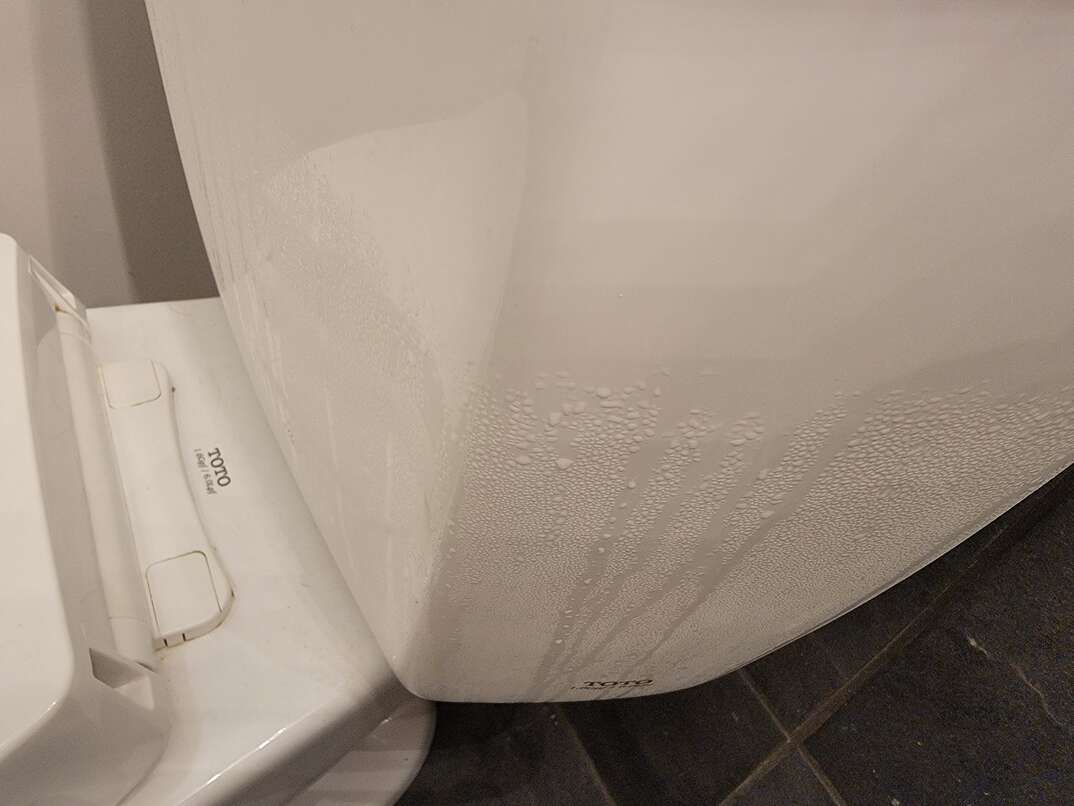- AppliancesElectriciansHVACLandscapingLocksmithPest ControlPlumbingRenovationRoofingT V RepairAll Home Improvement
- Car AccidentClass ActionCorporate LawCriminal DefenseDivorce LawEmployment LawFamily LawFinancial LawLegal AidMedical Injury LawyersMedical MalpracticeReal Estate LawWater Fire RestorationAll Legal
- InvestmentRetirementAll Finance
- Animal InsuranceAutoGeneral InsuranceHealth PolicyHome RentersAll Insurance
- DentalHealth SpecialistsAll Medical
- Animal CareVeterinaryAll Pets
- Auto GlassTowingAll Automotive
How to Stop your Toilet From Sweating: 3 Methods to Try

Does your toilet look like it’s just finished running a marathon — sweating nonstop? Toilets do get a workout in busy bathrooms, but the cause of condensation on a toilet tank has more to do with the air in the room than the toilet itself.
Here's what you can do to stop this condensation from forming in the first place.
Condensation on a toilet tank happens due to the right combination of environmental conditions. It's most common when the air temperature in the bathroom is high, and the relative humidity is also high. The water in toilet tanks is usually quite a bit colder than the air, which also makes the toilet tank cold. The temperature difference causes the moisture in the air to collect on the toilet tank as water droplets.
How to Stop the Condensation From Forming
Making a few changes to the bathroom environment or your toilet can help reduce the risk of condensation on a toilet tank. Here are some methods to try.
1. Reduce the Humidity in the Bathroom
Condensation forms when the humidity level is high. The moisture level is naturally high in the bathroom due to all of the water, but you can reduce it by changing your habits.
- Run the exhaust fan. If your bathroom has an exhaust fan, run it before, during and after showers to draw out some of the excess humidity.
- Use your air conditioner. Running the air conditioner when the weather warms up helps keep the bathroom cooler for less of a temperature difference. The AC also helps remove humidity from the air, which can cut down on the condensation on a toilet tank.
- Use a dehumidifier. Another effective way to reduce moisture in the bathroom is to run a dehumidifier. Empty it frequently to keep it operating properly.
2. Make Changes to the Toilet
You can also make a few alterations to your toilet to help reduce the condensation.
- Insulate the toilet. Insulation kits line the inside of your toilet to create a barrier between the cold water and warm bathroom air. To install the kit, you need to empty the tank and put the liner inside the tank. Some people also use bubble wrap or similar materials for a DIY version.
- Cover the toilet tank. You can also install a cover on the outside of the toilet tank. It's easy to install, and it soaks up the condensation on the toilet. You can take it off to wash it as needed.
- Add an anti-sweat valve. You can also install an anti-sweat valve on the toilet to warm up the water. It lets a little hot water into the tank to warm up the water, which reduces the risk of condensation on the coil toilet bowl. You can get preset or adjustable types. The adjustable valves let you change the water temperature or shut off the hot water if you don't need it.
- Replace the toilet. Newer toilets come with options that reduce condensation. Low-flow toilets use less water, which means they have less water in the tank and a lower risk of developing condensation. You can also get toilets with built-in insulation.
- Repair the flapper. When your toilet flapper doesn't seal properly, the water leaks into the bowl. This causes more water to go into the tank. The replacement water is cold, which can keep the water in the tank cold without giving it a chance to warm up. Replacing the flapper can cut down on the condensation.
3. Change Your Showering Habits
The shower is a major source of moisture in your bathroom, so changing the way you shower can help reduce condensation on the toilet tank. Keeping your showers shorter and using cooler water helps keep the room a little cooler with less humidity. When you're done showering, dry the walls to get rid of the moisture. Leaving the bathroom door open after you shower also helps by letting the moisture disperse.
Occasional moisture on your tank might not be a big deal, but lots of condensation on a toilet tank can eventually cause issues.
If toilet sweating happens frequently or heavily, the water can drip off the tank and onto the floor. Prolonged wetness on the floor could cause it to rot or mold, depending on the flooring material. It could also cause corrosion of the bolts that hold your toilet in place.
For a quick fix, you can place a drip tray underneath the toilet to catch the water. While it doesn't stop the condensation, it can keep the water drips from reaching the floor.
Elocal Editorial Content is for educational and entertainment purposes only. Editorial Content should not be used as a substitute for advice from a licensed professional in your state reviewing your issue. Systems, equipment, issues and circumstances vary. Follow the manufacturer's safety precautions. The opinions, beliefs and viewpoints expressed by the eLocal Editorial Team and other third-party content providers do not necessarily reflect the opinions, beliefs and viewpoints of eLocal or its affiliate companies. Use of the Blog is subject to the
Website Terms and Conditions.The eLocal Editorial Team operates independently of eLocal USA's marketing and sales decisions.



